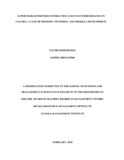| dc.description.abstract | The study investigated the influence of supervisor–supervisee interactions on staff performance
at Ministry of Energy and Mineral Development in Uganda. The researcher’s motive was to find
out whether supervisor-supervisee interaction could in any way influence or bear positive or
negative effect on performance. The study was guided by specific objectives which were to
examine the influence of communication flow on staff performance at ministry of energy and
mineral development in Uganda, to examine the influence of decision making on staff
performance at Ministry of Energy and Mineral Development and to explore the influence of
non- monetary support systems on staff performance at Ministry of Energy and Mineral
Development. Research data was collected from a sample of 152 respondents including;
Executive management (Assistant Commissioner, Undersecretary), Principle officers, senior
officers, permanent officers, contract and temporally officers using, simple random sampling and
purposive methods. The researcher used a 5-point Likert scale questionnaire and two interview
guides to collect data. Pearson product of moment correlation coefficient test was used to
establish the relationship between the supervisor-supervisee interactions and staff performance
while Linear regression-analysis was used to establish the degree to which independent variable
influences the dependent variable. The results of the study revealed that the selected supervisor
supervisee interaction practice/dimensions explained 47.3% of staff performance while 52.7%
was explained by other factors. The results of the study also indicated that non-financial support
system with the highest beta coefficient of ( =0.310, p<0.05) has the greatest influence on staff
performance followed by communication flow ( =0.244, p<0.05) and last Participatory decision
making ( =229, p<0.05). This implied that the three dimensions of supervisor-supervisee
interaction have a significant influence on staff performance at MEMD. | en_US |

